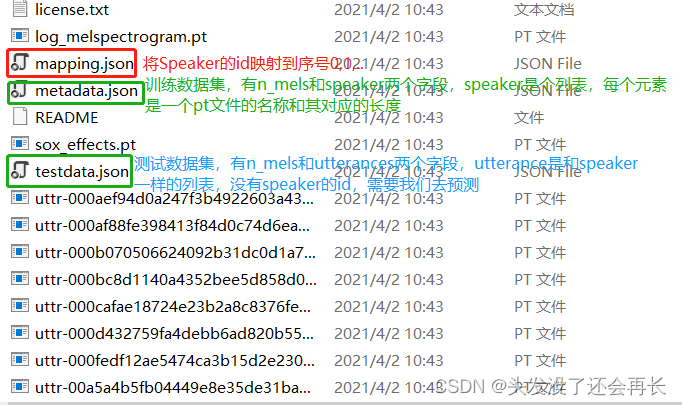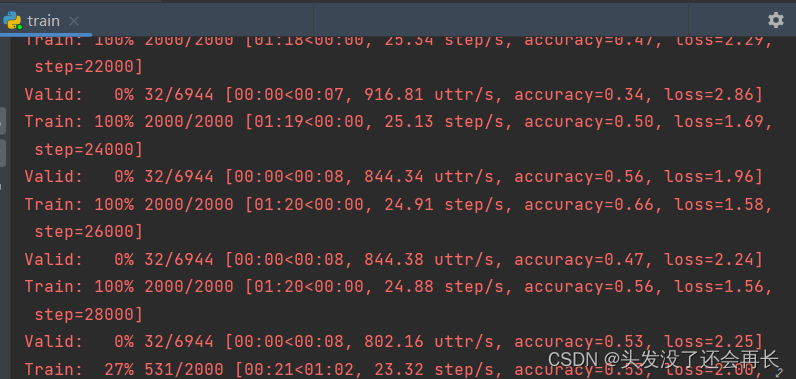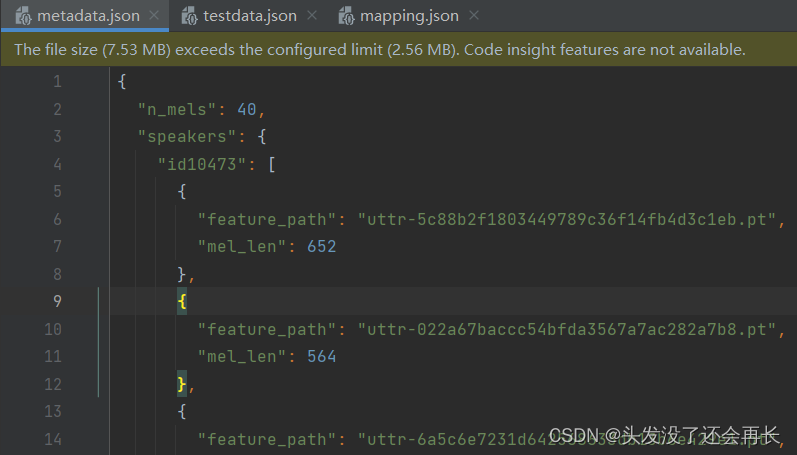【李宏毅】深度学习——HW4-Speaker Identification
Speaker Identification
1.Goal
根据给定的语音内容,识别出说话者是谁
2.Data formats
2.1data directory
目录下有三个json文件和很多pt文件,三个json文件作用标注在下图中,pt文件就是语音内容。

mapping文件
metadata文件
n_mels:The demission of mel-spectrogram(特征数是40)
speakers: A dictionary
- key: speaker id
- value: feature_path and mel_len
可以发现,pt文件内容长度不一样,所以后期需要我们自己统一长度
testdata文件
3.DataSet
构建自己的Dataset类,需要知道数据集的地址,由于每个数据长度不一样,所以还要规定数据的长度,返回值应该是,语音数据和对应的speaker的label
Dataset有三个重要的方法需要重写
- __init__(): 初始化,一般用于读取给定的数据到内存,在该任务中,需要从给定的路径中,读取语音path和label到data数组,读取mapping将speaker的id映射为对应序号。
- __getitem__(): 该方法根据传入的参数返回指定id的数据,在该任务中,对于传入的id,我们从data数组取出path和label,并将指定path的语音数据读出后分割,最后返回语音片段和对应的label。
- __len__(): 该方法返回数据集的长度,在该任务中,数据集的长度即data数组的长度。
代码如下:
import os
import json
import torch
import random
from pathlib import Path
from torch.nn.utils.rnn import pad_sequence
from torch.utils.data import Dataset
class myDataset(Dataset):
def __init__(self, data_dir, segment_len=128):
self.data_dir = data_dir
self.segment_len = segment_len
# Load the mapping from speaker neme to their corresponding id.
mapping_path = Path(data_dir) / "mapping.json"
mapping = json.load(mapping_path.open())
self.speaker2id = mapping["speaker2id"] # 在mapping.json 文件中 字典的key是speaker2id
# Load metadata of training data.
metadata_path = Path(data_dir) / "metadata.json"
metadata = json.load(open(metadata_path))["speakers"]
# get the total number of speaker
self.speaker_num = len(metadata.keys())
self.data = []
for speaker in metadata.keys():
for utterance in metadata[speaker]:
self.data.append([utterance["feature_path"], self.speaker2id
[speaker]])
def __len__(self):
return len(self.data)
def __getitem__(self, index):
feature_path, speaker = self.data[index]
# Load preprocessed mel-spectrogram.
mel = torch.load(os.path.join(self.data_dir, feature_path))
# segment mel-spectrogram into "segment_len" frames.
if len(mel) >self.segment_len:
start = random.randint(0, len(mel)-self.segment_len) #随便选取一个开始截取的位置 这个位置往后的长度要大于segment_len
mel = torch.FloatTensor(mel[start:start+self.segment_len])
else:
mel = torch.FloatTensor(mel)
# Turn the speaker id into long for computing loss later.
speaker = torch.FloatTensor([speaker]).long
return mel, speaker
def get_speaker_number(self):
return self.speaker_num
最后的数据中,发言人一共600个,语音一共69438个
4.DataLoader
DataLoader的完整参数列表
class torch.utils.data.DataLoader( dataset, batch_size=1, shuffle=False, sampler=None, batch_sampler=None, num_workers=0, collate_fn=<function default_collate>, pin_memory=False, drop_last=False, timeout=0, worker_init_fn=None)其中有一个参数
collate_fn,可能比较陌生
collate_fn作用:
在最后一步堆叠的时候可能会出现问题: 如果一条数据中所含有的每个数据元的长度不同, 那么将无法进行堆叠. 如: multi-hot类型的数据, 序列数据。在使用这些数据时, 通常需要先进行长度上的补齐, 再进行堆叠. 以现在的流程, 是没有办法加入该操作的。此外, 某些优化方法是要对一个batch的数据进行操作。collate_fn函数就是手动将抽取出的样本堆叠起来的函数。
所以我们需要自己定义collate_fn函数来统一特征大小
def collate_batch(batch):
# Process features within a batch
mel, speaker = zip(*batch)
# Because we train the model batch by batch, we need to pad the features in the same batch to make their lengths the same
mel = pad_sequence(mel, batch_first=True, padding_value=-20) # pad long 10^(-20) ehich is small value.
# mel: (batch size, length, 40)
return mel, torch.FloatTensor(speaker).long()
然后定义自己的dataloader,并在DataLoader中划分训练集和验证集
def get_dataloader(data_dir, batch_size, n_workers):
dataset = myDataset(data_dir)
speaker_num = dataset.get_speaker_number()
# split
trainlen = int(0.9 * len(dataset))
lengths = [trainlen, len(dataset) - trainlen]
trainset, validset = random_split(dataset, lengths)
train_loader = DataLoader(
trainset,
batch_size=batch_size,
shuffle=True,
num_workers=n_workers,
drop_last=True,
pin_memory=True,
collate_fn=collate_batch,
)
valid_loader = DataLoader(
validset,
batch_size=batch_size,
num_workers=n_workers,
drop_last=True,
pin_memory=True,
collate_fn=collate_batch,
)
return train_loader, valid_loader
5.Define Model
分类器是由transformerEncoder和全连接层构成的,输入是mels(shape为[batch size, length, 40]),输出是out(shape为[batch size, length, d_model])
# -*- coding = utf-8 -*-
# @Time : 2023/4/7 14:44
# @Author : 头发没了还会再长
# @File : mdoel.py
# @Software : PyCharm
import torch
import torch.nn as nn
import torch.nn.functional as F
# 分类器 使用transformer
class Classifier(nn.Module):
def __init__(self, d_model=80, n_spks=600, dropout=0.1):
super().__init__()
# project the dimession of features from that of input into d_model
self.prenet = nn.Linear(40, d_model)
self.encoder_layer = nn.TransformerEncoderLayer(
d_model=d_model, dim_feadforeard=256, nhead=2
)
self.pred_layer = nn.Sequential(
nn.Linear(d_model, d_model),
nn.ReLU(),
nn.Linear(d_model, n_spks),
)
def forward(self, mels):
'''
:param mels: (batch size, length, 40)
:return: (batch size, length, d_model)
'''
out = self.prenet(mels)
out = out.permute(1, 0, 2)
out = self.encoder_layer(out)
out = out.transpose(0, 1)
stats = out.mean(dim=1)
out = self.pred_layer(stats)
return out
6.Train and Valid
6.1 learning rate schedule
The warmup schedule
- Set learning rate to 0 in the beginning
- The learning rate increases linearly from 0 to initial learning rate during warmup period
import math
import torch
from torch.optim import Optimizer
from torch.optim.lr_scheduler import LambdaLR
def get_cosine_schedule_with_warmup(
optimizer: Optimizer,
num_warmup_steps: int,
num_training_steps: int,
num_cycles: float = 0.5,
last_epoch: int = -1,
):
"""
Create a schedule with a learning rate that decreases following the values of the cosine function between the
initial lr set in the optimizer to 0, after a warmup period during which it increases linearly between 0 and the
initial lr set in the optimizer.
Args:
optimizer (:class:`~torch.optim.Optimizer`):
The optimizer for which to schedule the learning rate.
num_warmup_steps (:obj:`int`):
The number of steps for the warmup phase.
num_training_steps (:obj:`int`):
The total number of training steps.
num_cycles (:obj:`float`, `optional`, defaults to 0.5):
The number of waves in the cosine schedule (the defaults is to just decrease from the max value to 0
following a half-cosine).
last_epoch (:obj:`int`, `optional`, defaults to -1):
The index of the last epoch when resuming training.
Return:
:obj:`torch.optim.lr_scheduler.LambdaLR` with the appropriate schedule.
"""
def lr_lambda(current_step):
# Warmup
if current_step < num_warmup_steps:
return float(current_step) / float(max(1, num_warmup_steps))
# decadence
progress = float(current_step - num_warmup_steps) / float(
max(1, num_training_steps - num_warmup_steps)
)
return max(
0.0, 0.5 * (1.0 + math.cos(math.pi * float(num_cycles) * 2.0 * progress))
)
return LambdaLR(optimizer, lr_lambda, last_epoch)
6.2定义model_fn
输入一组batch,输出损失和准确率
def model_fn(batch, model, criterion, device):
mels, labels = batch
mels = mels.to(device)
labels = labels.to(device)
outs = model(mels)
loss = criterion(outs, labels)
preds = outs.argmax(1)
accuracy = torch.mean((preds == labels).float())
return loss, accuracy
6.3 validation
def valid(dataloader, model, criterion, device):
"""Validate on validation set."""
model.eval()
running_loss = 0.0
running_accuracy = 0.0
pbar = tqdm(total=len(dataloader.dataset), ncols=0, desc="Valid", unit=" uttr")
for i, batch in enumerate(dataloader):
with torch.no_grad():
loss, accuracy = model_fn(batch, model, criterion, device)
running_loss += loss.item()
running_accuracy += accuracy.item()
pbar.update(dataloader.batch_size)
pbar.set_postfix(
loss=f"{running_loss / (i+1):.2f}",
accuracy=f"{running_accuracy / (i+1):.2f}",
)
pbar.close()
model.train()
return running_accuracy / len(dataloader)
6.4 有了前期的准备,就可以开始训练模型了
- 首先,需要准备训练数据,即加载dataloader,定义损失函数,优化器等
- 然后开始循环,在训练集上计算梯度反向传播,在验证集上计算准确率
- 存储最优的模型
def parse_args():
"""arguments"""
config = {
"data_dir": "./Dataset",
"save_path": "model.ckpt",
"batch_size": 32,
"n_workers": 8,
"valid_steps": 2000,
"warmup_steps": 1000,
"save_steps": 10000,
"total_steps": 70000,
}
return config
def main(
data_dir,
save_path,
batch_size,
n_workers,
valid_steps,
warmup_steps,
total_steps,
save_steps,
):
"""Main function."""
device = torch.device("cuda" if torch.cuda.is_available() else "cpu")
print(f"[Info]: Use {device} now!")
train_loader, valid_loader, speaker_num = get_dataloader(data_dir, batch_size, n_workers)
train_iterator = iter(train_loader)
print(f"[Info]: Finish loading data!",flush = True)
model = Classifier(n_spks=speaker_num).to(device)
criterion = nn.CrossEntropyLoss()
optimizer = AdamW(model.parameters(), lr=1e-3)
scheduler = get_cosine_schedule_with_warmup(optimizer, warmup_steps, total_steps)
print(f"[Info]: Finish creating model!",flush = True)
best_accuracy = -1.0
best_state_dict = None
pbar = tqdm(total=valid_steps, ncols=0, desc="Train", unit=" step")
for step in range(total_steps):
# Get data
try:
batch = next(train_iterator)
except StopIteration:
train_iterator = iter(train_loader)
batch = next(train_iterator)
loss, accuracy = model_fn(batch, model, criterion, device)
batch_loss = loss.item()
batch_accuracy = accuracy.item()
# Updata model
loss.backward()
optimizer.step()
scheduler.step()
optimizer.zero_grad()
# Log
pbar.update()
pbar.set_postfix(
loss=f"{batch_loss:.2f}",
accuracy=f"{batch_accuracy:.2f}",
step=step + 1,
)
# Do validation
if (step + 1) % valid_steps == 0:
pbar.close()
valid_accuracy = valid(valid_loader, model, criterion, device)
# keep the best model
if valid_accuracy > best_accuracy:
best_accuracy = valid_accuracy
best_state_dict = model.state_dict()
pbar = tqdm(total=valid_steps, ncols=0, desc="Train", unit=" step")
# Save the best model so far.
if (step + 1) % save_steps == 0 and best_state_dict is not None:
torch.save(best_state_dict, save_path)
pbar.write(f"Step {step + 1}, best model saved. (accuracy={best_accuracy:.4f})")
pbar.close()
if __name__ == "__main__":
main(**parse_args())
这是训练过程中的截图:

7.Test
训练完模型,我们会得到最好的参数,并且保存在model.ckpt文件中了,接下来,只需要定义训练的函数,使用保存的最优模型开始训练即可。
测试和训练基本相同,需要准备dataset,dataloader
7.1 Inference dataset
class InferenceDataset(Dataset):
def __init__(self, data_dir):
testdata_path = Path(data_dir)
metadata = json.load(testdata_path.open())
self.data_dir = data_dir
self.data = metadata["utterances"]
def __len__(self):
return len(self.data)
def __getitem__(self, index):
utterance = self.data[index]
feature_path = utterance["feature_path"]
mel = torch.load(os.path.join(self.data_dir, feature_path))
return feature_path, mel
7.2可以开始预测啦
def inference_collate_batch(batch):
feature_paths, mels = zip(*batch)
return feature_paths, torch.stack(mels)
def parse_args():
"""arguments"""
config = {
"data_dir": "dataset",
"model_path": "./model.ckpt",
"output_path": "./output.csv",
}
return config
def main(data_dir,model_path,output_path,):
device = torch.device("cuda" if torch.cuda.is_available() else "cpu")
print(f"[Info]: Use {device} now!")
mapping_path = Path(data_dir) / "mapping.json"
mapping = json.load(mapping_path.open())
dataset = InferenceDataset(data_dir)
dataloader = DataLoader(
dataset,
batch_size=1,
shuffle=False,
drop_last=False,
num_workers=0,
collate_fn=inference_collate_batch,
)
print(f"[Info]: Finish loading data!", flush=True)
speaker_num = len(mapping["id2speaker"])
model = Classifier(n_spks=speaker_num).to(device)
model.load_state_dict(torch.load(model_path))
model.eval()
print(f"[Info]: Finish creating model!", flush=True)
results = [["Id", "Category"]]
for feat_paths, mels in tqdm(dataloader):
with torch.no_grad():
mels = mels.to(device)
outs = model(mels)
preds = outs.argmax(1).cpu().numpy()
for feat_path, pred in zip(feat_paths, preds):
results.append([feat_path, mapping["id2speaker"][str(pred)]])
with open(output_path, 'w', newline='') as csvfile:
writer = csv.writer(csvfile)
writer.writerows(results)



